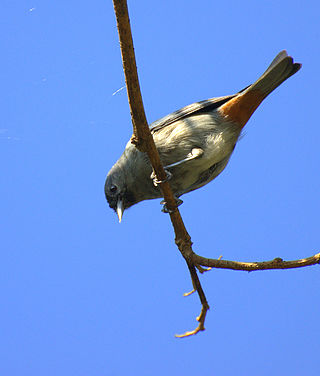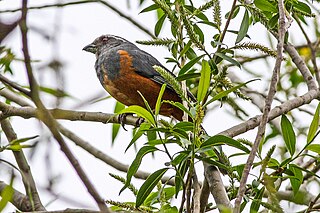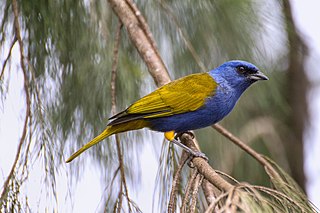
The black-faced antthrush, is a species of passerine bird in the family Formicariidae.

The tit-like dacnis is a small neotropical passerine bird found in southern Ecuador and Peru. In Spanish, it is known as Azulito Altoandino. It is found in Andean montane scrub forests from 3000 m to 4600 m elevation.

Haplospiza is a small genus of birds in the tanager family Thraupidae. Formerly classified in the bunting and American sparrow family Emberizidae, more recent studies have shown it to belong in the Thraupidae. Its two members breed in subtropical or tropical moist forest in Central and South America. They are often associated with bamboo.

Typical conebills belong to the tanager genus Conirostrum. They are small tanagers (9–14 cm) found in the forests of South America. They feed in pairs or small flocks by gleaning insects from foliage.

The black-goggled tanager is a species of bird in the family, Thraupidae. It is the only member of the genus Trichothraupis. It is found at low levels in forest and woodland in a large part of eastern and southern Brazil, eastern Paraguay and far north-eastern Argentina, with a disjunct population along the East Andean slope in Peru, Bolivia and far north-western Argentina. While generally common and widespread, and consequently considered to be of least concern by BirdLife International and IUCN, the population associated with the Andes is relatively local and uncommon.

Phrygilus is a genus of mainly Andean seed-eating tanagers commonly known as sierra finches. Phrygilos means finch in Ancient Greek. Traditionally classified in the bunting and American sparrow family Emberizidae, more recent studies have shown them to belong in the Thraupidae.

The cinereous finch is a species of South American bird in the tanager family Thraupidae. It is the only member of the genus Piezorina. It is found in arid coastal regions of northern Peru, with a single record, presumably a straying bird, from immediately adjacent Ecuador.

Poospiza is a genus of finch-like birds in the tanager family Thraupidae that are found in both the South American lowlands and the Andes mountains. Generally they are arboreal feeders in light woodland and scrub. All have extensive grey to their plumage, and have—often bold—white or rufous markings.

The chestnut-headed tanager is a species of bird in the tanager family Thraupidae this is found in the Atlantic Forest of southeast Brazil, eastern Paraguay and far northeastern Argentina. It was formerly the only member of the genus Pyrrhocoma but is now placed in Thlypopsis.

The rufous-bellied mountain tanager or rufous-bellied saltator is a species of songbird in the tanager familily Thraupidae and is the only member of the genus Pseudosaltator. It is found in the eastern Andes of southern Bolivia and extreme northern Argentina. It occurs mostly at altitudes from 3000 m to 4000 m. Its habitat is open land, including cultivated land, that has patches of scrub, alder trees, or Polylepis trees. It is threatened by habitat loss.

The hooded mountain tanager is a species of bird in the tanager family Thraupidae. It is the only member of the genus Buthraupis. This yellow, blue and black tanager is found in forest, woodland and shrub in the Andean highlands of Bolivia, Colombia, Ecuador, Peru, and Venezuela. At 23 centimetres (9.1 in) and 85 grams (3.0 oz), it is one of the largest tanagers.

The plushcap is a species of bird in the tanager family Thraupidae and it is the only member of the genus Catamblyrhynchus.

The grey-hooded bush tanager is a species of South American bird in the tanager family Thraupidae. It is the only member of the genus Cnemoscopus. It is found in Bolivia, Colombia, Ecuador, Peru, and Venezuela. Its natural habitat is subtropical or tropical moist montane forests.

The long-tailed reed finch is a species of South American bird in the tanager family Thraupidae. It is the only member of its genus Donacospiza.

The grey-headed tanager is a widely distributed species of small Neotropical bird in the tanager family Thraupidae. It is the only member of the genus Eucometis.

The grey-crested finch is a species of bird in the tanager family Thraupidae. It is found in Bolivia and northwestern Argentina where its natural habitats are subtropical or tropical high-altitude shrubland and heavily degraded former forest. The bird was first described in 1837 by the French ornithologist Frédéric de Lafresnaye and the French zoologist Alcide d'Orbigny after the latter had collected it on an expedition he undertook for the Paris Museum to South America between 1826 and 1833.

The mourning sierra finch is a species of South American bird in the tanager family Thraupidae. It is the only member of the genus Rhopospina.

The bright-rumped yellow finch is a species of bird in the family Thraupidae. It is found in the Puna grassland: Peru, Bolivia and northern Chile and Argentina. Its natural habitats are subtropical or tropical high-altitude grassland and heavily degraded former forest.

The orange-headed tanager is a species of bird in the family Thraupidae. Native to South America, it is found in Argentina, Bolivia, Brazil, Colombia, Ecuador, Paraguay, Peru, and Venezuela, where it inhabits successional vegetation, cerrado, riparian forest, shrub, brush, and open woodland. Males of the species have sandy-gray upperparts, cinnamon to buff underparts, white on the center of the lower breast, belly, and tail, and rufous-orange and yellow heads. Females are similar but duller.

The blue-capped tanager is a species of bird in the tanager family Thraupidae. It was formerly placed in the genus Thraupis but is now the only species in the genus Sporathraupis.























